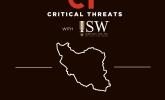Iran Crisis Update, October 9
October 9, 2022 - ISW Press
Iran may be preparing to escalate militarily against its foreign adversaries, including the US, in response to the ongoing, anti-regime protests. Likely Iranian-backed militants conducted a rocket attack against a US military base in northeastern Syria on October 8. Supreme Leader Ali Khamenei and other senior political and security officials have accused the US, Israel, and Saudi Arabia of coopting and stoking the protests in recent days. Senior Iranian military officers released a statement vowing to retaliate on October 6. Iranian forces or proxies may conduct additional attacks against US positions in the Middle East, especially in Iraq and Syria, in response to what they claim is Washington’s role in the protests.








